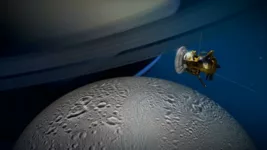The NASA probe Cassini will be flying as close as 30 miles (48 km) over Enceladus, through the geyser-like eruptions on its south pole.
The eruptions are believed to originate from the liquid-water oceans presumed under the moon’s icy surface. Scientists are excited to get a sample of the water shooting up from the surface. Although the probe can not search for signs of life it can help estimate Enceladus’s potential to sustain or develop life.
Linda Spilker, a Cassini project scientist, says the flyby has three objectives:
The mission team aims to confirm the presence of molecular hydrogen in the plume, which would provide evidence for hydrothermal activity (a potential energy source for life) in the ocean. The team also hopes to characterize the plume’s chemistry (perhaps finding previously undetected organic compounds) and determine the nature of the plume sources (discrete jets versus broader, curtainlike eruptions).








